Market Square ca. 1912 source: winterbos on Flickr
Winnipeg has had a 'Market Square' since 1889. That year, a public market building was erected to the west of city hall, the present site of the Public Safety Building. Buildings on the surrounding streets faced the market and as a result the district as a whole became known as Market Square.
Winnipeg Daily Sun, May 1884.
It was also the scene of ceremonies, social events, march-bys from troops off to war and public discourse and unrest, especially during the 1919 Winnipeg General Strike.

In 1964 - 65 city hall, the market building, the main fire hall and an entire block of buildings to the east of city hall were razed to make way for the current Civic Centre. The promised rejuvenation that this new development was to bring did not materialize and the area became run down and neglected.
Winnipeg fell behind cities like Montréal, Vancouver (Gastown) and Toronto in recognizing that there was value in preserving their built heritage. Taking note of developments around Canada, and even right here in Winnipeg with the 'Osborne Street Village', building owners mobilized.
The Old Market Square Association was created in the mid-1970s to lobby for improvements to 'Old Market Square', an area which had grown to include much of what we now know as the Exchange District. In 1976 the Heritage Canada Trust, a funder of restoration projects in other Canadian cities, announced a $500,000 grant to help with the purchase and restoration of significant buildings in the Old Market Square area, especially along Albert Street.
'Market Square' park in 1976 ( source) and 2007
A focal point for the transformation was known as Albert Street Park, the grassed-over site of the former main fire hall. In 1976 the OMSA announced the start of a weekly farmers' market at the park. A spokesman for the group, future city councillor Al Golden, told the Free Press that the market would be "... a key to the redevelopment of that whole area as a thriving tourist attraction for Winnipeg".
The farmer's market fueled the rejuvenation of the area. New businesses ranging from furniture outlets to restaurants like the Old Spaghetti Factory set up shop. The Association was able to convince the city to invest in new streetscaping, sidewalk improvements and park infrastructure.
Another key feature was Townsite. The Travellers Building at King and Bannatyne was subdivided into an indoor 'mall', similar to the Forks Market today. It housed over a dozen small shops selling men's clothing stores, fine coffees and antiques.
With the eighties came a tough economy and, ironically, strong competition from new and better funded government retail projects such as The Forks and Portage Place. The retail momentum had slowed but Old Market Square had created a niche as an entertainment district.
It was around this time that the area took on a new moniker: The Exchange District - leaving Old Market Square to refer mainly to the park.
In 1990 a permanent stage was built in the park and it soon became home base for many of the city's premiere summer events such as the Fringe and Jazz Festivals.
In 2008 a revitalization program began that included better drainage, new sod and more lighting. The crown jewel is a new $1.5m stage known as The Cube, the skin of which is made up of 20,000 aluminum links. Designed by 5468796 Architecture, the stage contains a built-in lighting system, green room and two performance levels.
Though the term 'Market Square' may mean a much smaller geographic space than it did a century ago it's an important part of the downtown of the city. Thanks recent renovations it could remain so for another 100 years !
Related:
Setting the Stage - Winnipeg Free Press
$1m stage - CTV
New Stage Interacts with passers-by Winnipeg Free Press
The Cube Opens - Exchange BIZ Media Release (pdf)
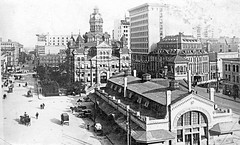
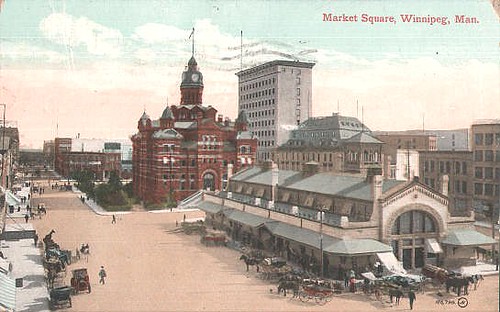




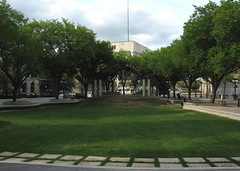





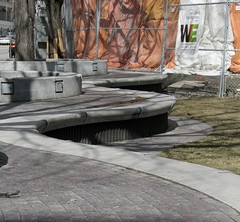
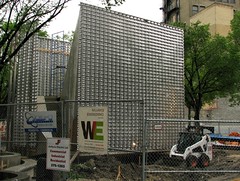
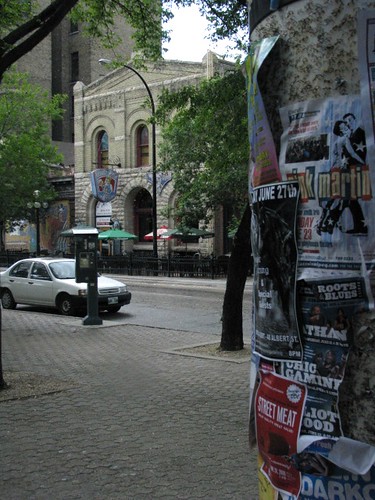
The Market building was shorn of its big awnings and ornamental roof to become the plain old Civic Offices bulding, which I remember from the 1950s and early 60s. I saw the basement as a kid (my father worked for the city as a maintenance man). All I remember is rows of big steel pipes from the central steam heating plant passing through the building. As I recall they were three or four inches in diameter and lay parallel to each other about three feet off the floor. They came in from the subterranian darkness through big stone archways. Most impressive to an 8-10 year old.
ReplyDelete